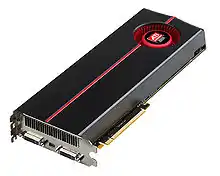Graphics hardware
Graphics hardware is computer hardware that generates computer graphics and allows them to be shown on a display, usually using a graphics card (video card) in combination with a device driver to create the images on the screen.

Types
Graphics Cards
The most important piece of graphics hardware is the graphics card, which is the piece of equipment that renders out all images and sends them to a display. There are two types of graphics cards:[1] integrated and dedicated. An integrated graphics card, usually by Intel to use in their computers, is bound to the motherboard and shares RAM(Random Access Memory) with the CPU, reducing the total amount of RAM available. This is undesirable for running programs and applications that use a large amount of video memory. A dedicated graphics card has its own RAM and Processor for generating its images, and does not slow down the computer. Dedicated graphics cards also have higher performance than integrated graphics cards. It is possible to have both[2] dedicated and integrated graphics, however once a dedicated graphics card is installed, the integrated card will no longer function until the dedicated card is removed.
Parts of a Graphics Card
The GPU,[3] or graphics processing unit, is the unit that allows the graphics card to function. It performs a large amount of the work given to the card. The majority of video playback on a computer is controlled by the GPU. Once again, a GPU can be either integrated or dedicated.
Video Memory is built in RAM installed on the video card that provides the graphics card with its own RAM and allows it to run smoothly without having to take resources from the computer. However, if one uses an integrated graphics card, the chip will take resources from the computer as it does not have its own built in memory. That is how it is made.
Display Drivers
A display driver is a piece of software which allows your graphics hardware to communicate with your operating system.[4] Drivers in general allow your computer to utilize parts of itself, and without them, the machine would not function. This is because usually a graphics device communicates in its own language, which is more sophisticated, and a computer communicates in its own language, which largely deals with general commands. Therefore, a driver is required to translate between the two, and convert general commands into specific commands, and vice versa, so that each of the devices can understand the instructions and results.
Installation
Dedicated graphics cards are not bound to the motherboard, and therefore most are removable, replaceable, or upgradable. They are installed in an expansion slot and connected to the motherboard. On the other hand, an integrated graphics card cannot be changed without buying a new motherboard with a better chip, as they are bound to the motherboard.
Also, if an integrated graphics card gets damaged or ceases to function, a new motherboard must be purchased to replace it, as it is bound to the motherboard and cannot be removed or replaced. On the other hand, if there is a problem with a dedicated graphics card, it can be replaced by installing another.
Drivers[5] for the hardware are installed through software downloaded or provided by the manufacturer. Each brand of graphics hardware has its own drivers that are required for the hardware to run appropriately.
Brands
The major competing brands in graphics hardware are NVidia and AMD. NVidia is known largely in the computer graphics department due to its GeForce brand, whereas AMD is known due to its Radeon brand. These two brands account for largely 100 percent of the graphics hardware market, with NVidia making 4 billion dollars[6] in revenue and AMD generating 6.5 billion in revenue (through all sales, not specifically graphics cards).
Costs
The Prices of different pieces of graphics hardware vary due to the power and speed of the piece. Most high end gaming pieces of hardware are dedicated graphics cards, and cost over $200, and can go as high as the price of a new computer, depending on the quality desired. In the graphics cards department, using integrated chips is much cheaper than buying a dedicated card, however the performance conforms to the price.
Also, computer graphics hardware usually generates a larger amount of heat, especially high end gaming pieces, and requires additional cooling systems to prevent overheating.[7] This may further raise the cost, although some dedicated graphics cards come with built-in fans.
References
- Arthur (2018-12-22). "6 Best Linux Distros of 2018 - Your Ultimate Choosing Guide". Best 7 Reviews. Retrieved 2019-08-16.
- "How can I enable onboard graphics AND dedicated card simultaneously?". Super User. Retrieved 2019-08-16.
- http://www.notebookreview.com/default.asp?newsID=4563
- PARR, E.A. (1993), "Display Devices and Drivers", Logic Designer's Handbook, Elsevier, pp. 250–269, doi:10.1016/b978-0-7506-0535-9.50015-3, ISBN 9780750605359
- http://www.webopedia.com/TERM/D/driver.html
- "Archived copy". Archived from the original on 2013-01-30. Retrieved 2012-11-18.CS1 maint: archived copy as title (link)
- http://smallbusiness.chron.com/hardware-used-computer-graphics-29697.html
http://www.maximumpc.com/article/features/amd_vs_nvidia_10_videocards_go_head--head
See also
External links
 Media related to Graphics hardware at Wikimedia Commons
Media related to Graphics hardware at Wikimedia Commons
